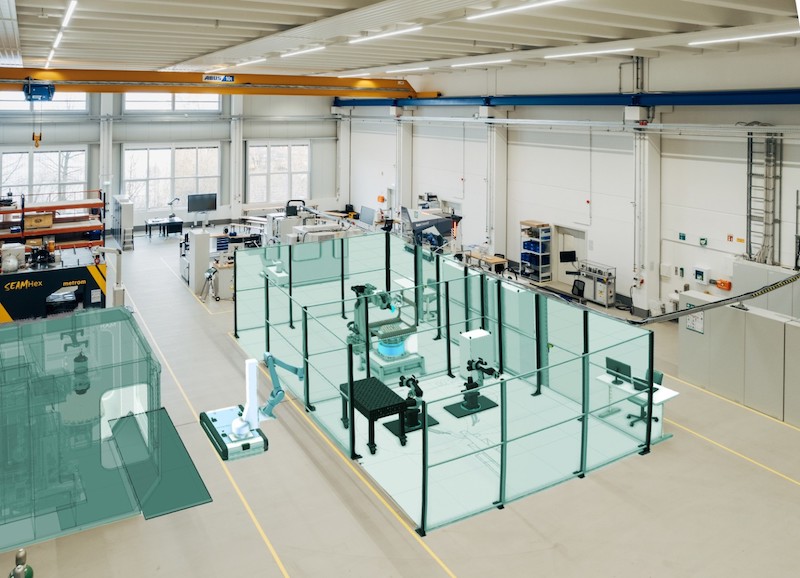
Fraunhofer designs robotic production system that is ‘as versatile as a Swiss Army knife’
The Fraunhofer Institute for Machine Tools and Forming Technology has designed a new robotic production system that it says is “as versatile as a Swiss Army knife”.
Fraunhofer says the system’s features and benefits include:
- it is utilization-optimized;
- flexibly arranged production modules equipped via driverless transport systems which can manufacture a variety of products;
- a production planning and control system that can flexibly allocate these modules;
- segmentation and intelligent distribution of manufacturing tasks; and
- possible to produce large-size components in small facilities.
Fraunhofer adds that its “Matrix production and SWAP-IT create a production infrastructure that enables highly efficient manufacturing of even smaller quantities”.
But that is not all. Such infrastructure also stimulates new ways of working when previously manual tasks need to be automated.
Relevant impulses for continuous further qualification come from the InTeleMat project: allowing businesses to rely on valuable human labor even more effectively.

Matrix production systems convince by their flexibility and ability to perfectly coordinate human labor, machines, and automated processes.
The Fraunhofer Institutes IWU and IPA highlight in their expertise prepared for acatech how much production is affected by changing conditions and the resulting options for action.
Prof. Dr. Steffen Ihlenfeldt, director of the institute at Fraunhofer IWU, states: “We observe that markets change quickly and unpredictably. Production refers to VUCA, an acronym for Volatility, Uncertainty, Complexity, and Ambiguity.
“Consequently, production must also undergo radical changes. We believe matrix architectures or, in general, flexible production systems are the perfect answer.”
In two ongoing projects, Fraunhofer IWU, together with partners, is developing entirely new process chains and methods for employee qualification for the flexible production of the future.
Fraunhofer Lighthouse Project SWAP
In the financial world, “SWAP” refers to an agreement between two parties to exchange assets or payment streams to mitigate risks.
The Fraunhofer Lead Project SWAP also focuses on this core concept: when production facilities can produce a wide variety of products and are flexibly interconnected, the risk of unintended shutdowns in the entire process chain is low, thanks to automatically generated production orders.
Fraunhofer IWU plays a central role in the Fraunhofer lead project SWAP. It contributes its technological expertise in the digitalization of production, processing of components with mobile machines, and the control, regulation, and networking of machines.
In the “large-size components” use case, the IWU explores an all-new process chain for manufacturing large workpieces using small standard machines.
The component is digitally segmented based on considerations of component strength and available machines, processed in individual parts, assembled, and finalized using a mobile machine.
The research institute also works on communication interfaces and protocols to ensure smooth information exchange between plant controls, driverless transport systems (DTS), and the overarching production system.
Together with Fraunhofer IOSB, it validates the software developed for SWAP, which must comply with uniform standards (such as OPC UA) and communicate with standard control software in the market.
At the Hannover Messe 2023, the Fraunhofer Institutes IWU and IOSB jointly presented their first use case, “Segmentation and Manufacturing of Large Components”, in the SWAP-IT architecture, along with the associated Production Flow Description Language (PFDL).
In the meantime, Dr. Arvid Hellmich’s team has restructured the test field at the Dresden site of the IWU into matrix architecture, with flexibly approachable production cells that FTS carriers can approach individually.
The PFDL developed in SWAP is used for orchestrating production orders to implement an exemplary process chain from 3D printing to assembly.
It utilizes three production cells, links real processes with their digital representation, and banks on FTS for logistical integration.
Dr. Arvid Hellmich: “In our test field, our team can demonstrate to customers how flexible production of a component, such as a seat shell, can be achieved using standard machines.”
InTeLeMat Project: Involving and Continuously Qualifying Employees in Matrix Production
Despite increasing automation and networking, humans remain crucial for productivity and quality.
The InTeLeMat project (Informal, technology-assisted learning systems in matrix production), funded by the Federal Ministry of Education and Research, tackles the challenge of developing innovative strategies, tools, and methods for employees to master complex production environments with confidence.
InTeLeMat is an initiative of Fraunhofer IWU, regional industrial partners, and research institutions. Supporting employees in continuously and independently acquiring qualifications and competencies on the job is a central concern of InTeLeMat. Tailor-made assistance systems are among the solutions under development.
SWAP and matrix production are ultimately designed with humans in mind: where human creativity and flexibility are indispensable, humans need support to leverage their strengths even better in complex production systems.
When enterprises run out of skilled workers, the need for monotonous and physically demanding tasks to be automated is growing. Fraunhofer IWU is researching supportive processes and IT solutions required for this purpose.

